University Report: Management and Organizations in Global Environment
VerifiedAdded on 2020/03/04
|9
|1766
|40
Report
AI Summary
This report examines the concepts of management and organizations within a global context, focusing on rational decision-making and the application of linear programming. It analyzes the rational decision-making process, its steps, and limitations, along with the practical applications of linear programming in production planning. The report also provides an analysis of globalization based on Pankaj Ghemawat's TED Talk, challenging common assumptions about its impact on trade, immigration, and foreign aid. It discusses the fears associated with globalization, such as those related to immigration and foreign aid, and highlights the importance of accurate data in understanding the true extent of global integration. The author concludes that rational decision-making is crucial for organizational management and that a more realistic view of globalization can help address misconceptions.
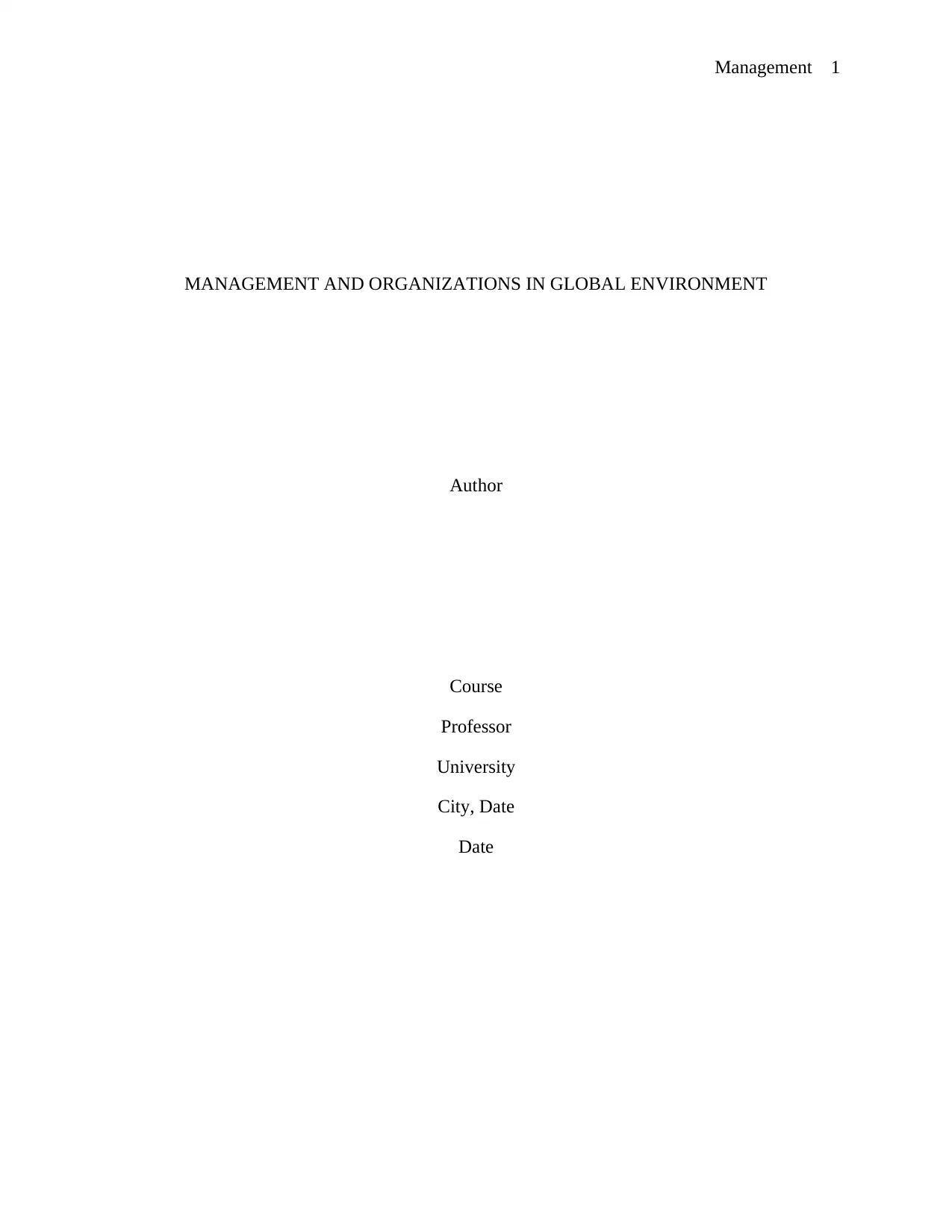
Management 1
MANAGEMENT AND ORGANIZATIONS IN GLOBAL ENVIRONMENT
Author
Course
Professor
University
City, Date
Date
MANAGEMENT AND ORGANIZATIONS IN GLOBAL ENVIRONMENT
Author
Course
Professor
University
City, Date
Date
Paraphrase This Document
Need a fresh take? Get an instant paraphrase of this document with our AI Paraphraser
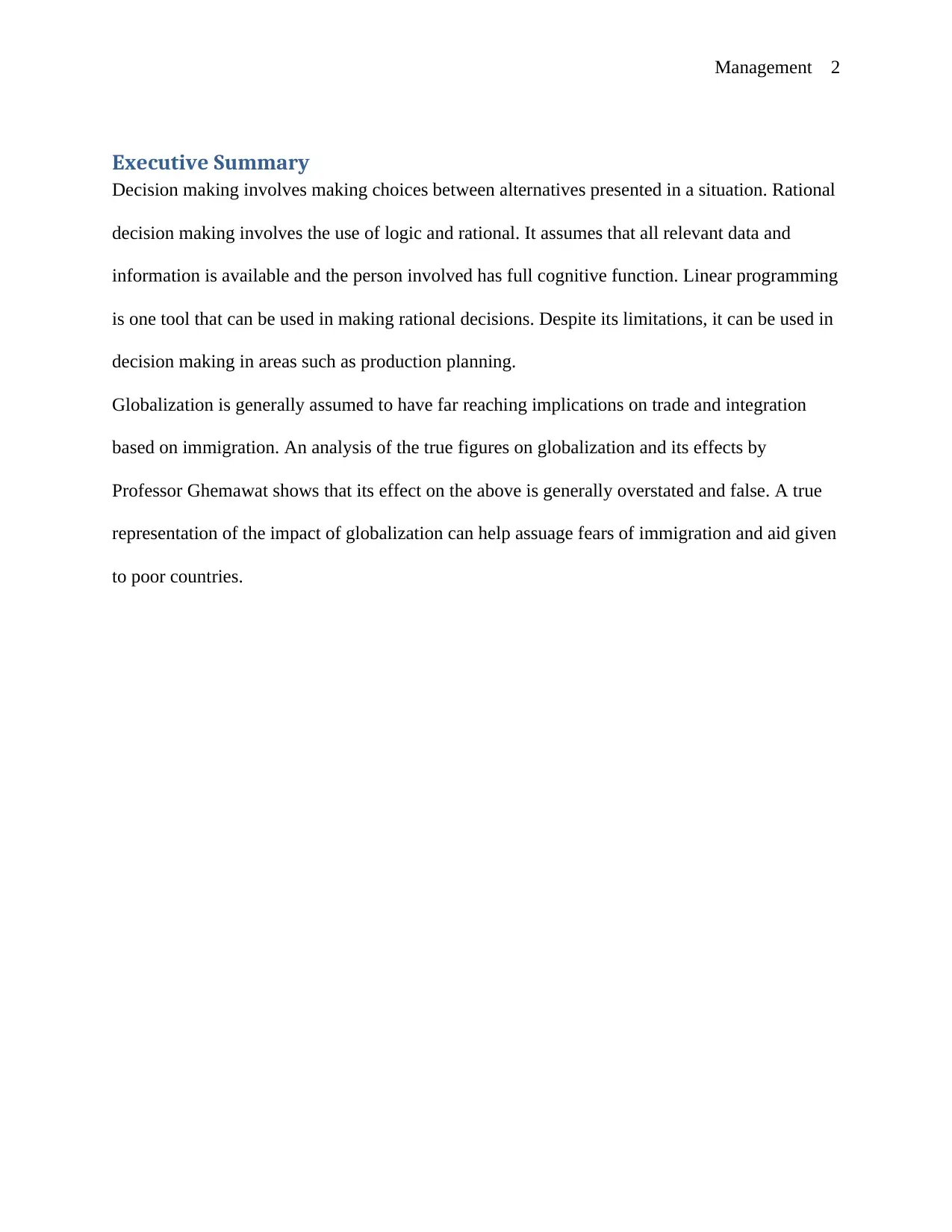
Management 2
Executive Summary
Decision making involves making choices between alternatives presented in a situation. Rational
decision making involves the use of logic and rational. It assumes that all relevant data and
information is available and the person involved has full cognitive function. Linear programming
is one tool that can be used in making rational decisions. Despite its limitations, it can be used in
decision making in areas such as production planning.
Globalization is generally assumed to have far reaching implications on trade and integration
based on immigration. An analysis of the true figures on globalization and its effects by
Professor Ghemawat shows that its effect on the above is generally overstated and false. A true
representation of the impact of globalization can help assuage fears of immigration and aid given
to poor countries.
Executive Summary
Decision making involves making choices between alternatives presented in a situation. Rational
decision making involves the use of logic and rational. It assumes that all relevant data and
information is available and the person involved has full cognitive function. Linear programming
is one tool that can be used in making rational decisions. Despite its limitations, it can be used in
decision making in areas such as production planning.
Globalization is generally assumed to have far reaching implications on trade and integration
based on immigration. An analysis of the true figures on globalization and its effects by
Professor Ghemawat shows that its effect on the above is generally overstated and false. A true
representation of the impact of globalization can help assuage fears of immigration and aid given
to poor countries.
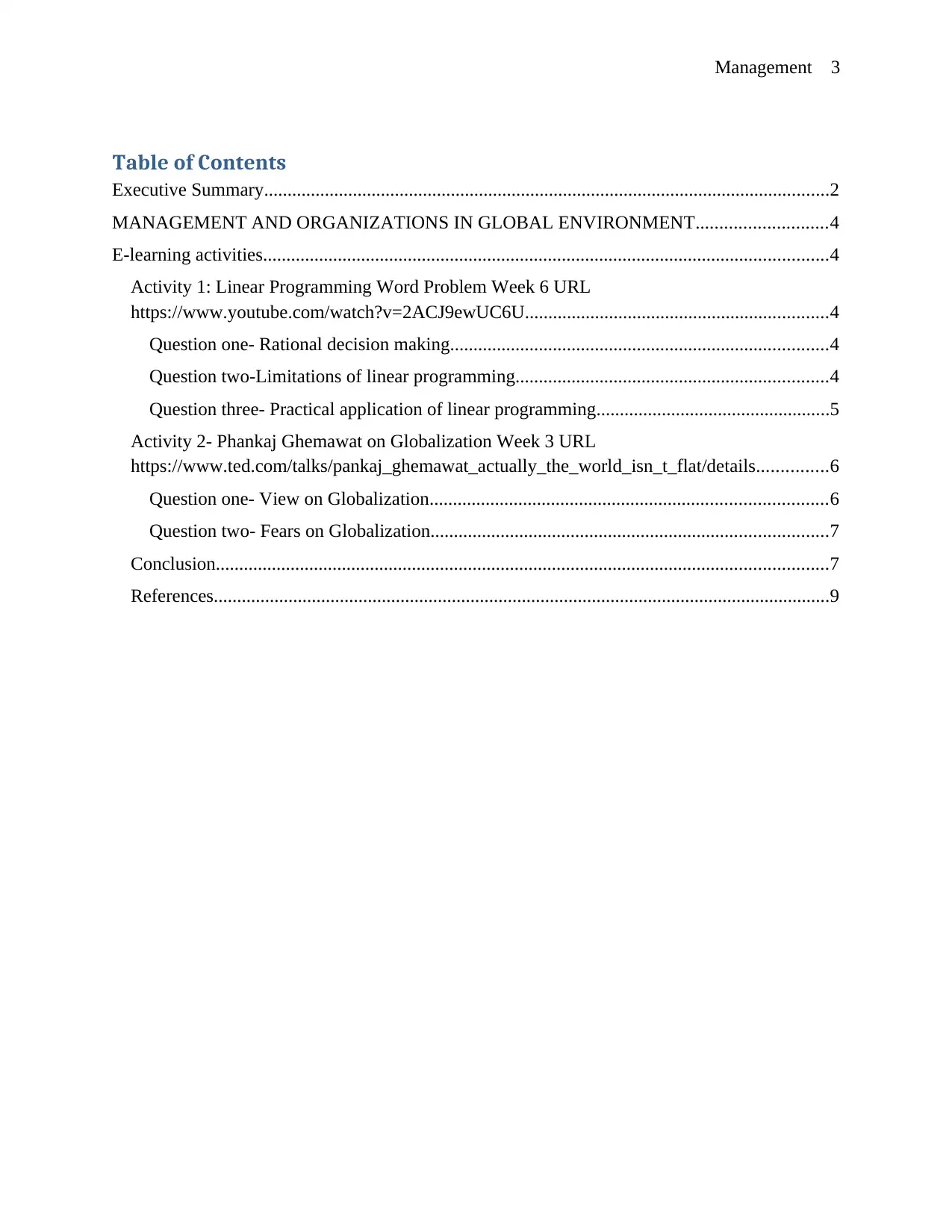
Management 3
Table of Contents
Executive Summary.........................................................................................................................2
MANAGEMENT AND ORGANIZATIONS IN GLOBAL ENVIRONMENT............................4
E-learning activities.........................................................................................................................4
Activity 1: Linear Programming Word Problem Week 6 URL
https://www.youtube.com/watch?v=2ACJ9ewUC6U.................................................................4
Question one- Rational decision making.................................................................................4
Question two-Limitations of linear programming...................................................................4
Question three- Practical application of linear programming..................................................5
Activity 2- Phankaj Ghemawat on Globalization Week 3 URL
https://www.ted.com/talks/pankaj_ghemawat_actually_the_world_isn_t_flat/details...............6
Question one- View on Globalization.....................................................................................6
Question two- Fears on Globalization.....................................................................................7
Conclusion...................................................................................................................................7
References....................................................................................................................................9
Table of Contents
Executive Summary.........................................................................................................................2
MANAGEMENT AND ORGANIZATIONS IN GLOBAL ENVIRONMENT............................4
E-learning activities.........................................................................................................................4
Activity 1: Linear Programming Word Problem Week 6 URL
https://www.youtube.com/watch?v=2ACJ9ewUC6U.................................................................4
Question one- Rational decision making.................................................................................4
Question two-Limitations of linear programming...................................................................4
Question three- Practical application of linear programming..................................................5
Activity 2- Phankaj Ghemawat on Globalization Week 3 URL
https://www.ted.com/talks/pankaj_ghemawat_actually_the_world_isn_t_flat/details...............6
Question one- View on Globalization.....................................................................................6
Question two- Fears on Globalization.....................................................................................7
Conclusion...................................................................................................................................7
References....................................................................................................................................9
⊘ This is a preview!⊘
Do you want full access?
Subscribe today to unlock all pages.

Trusted by 1+ million students worldwide
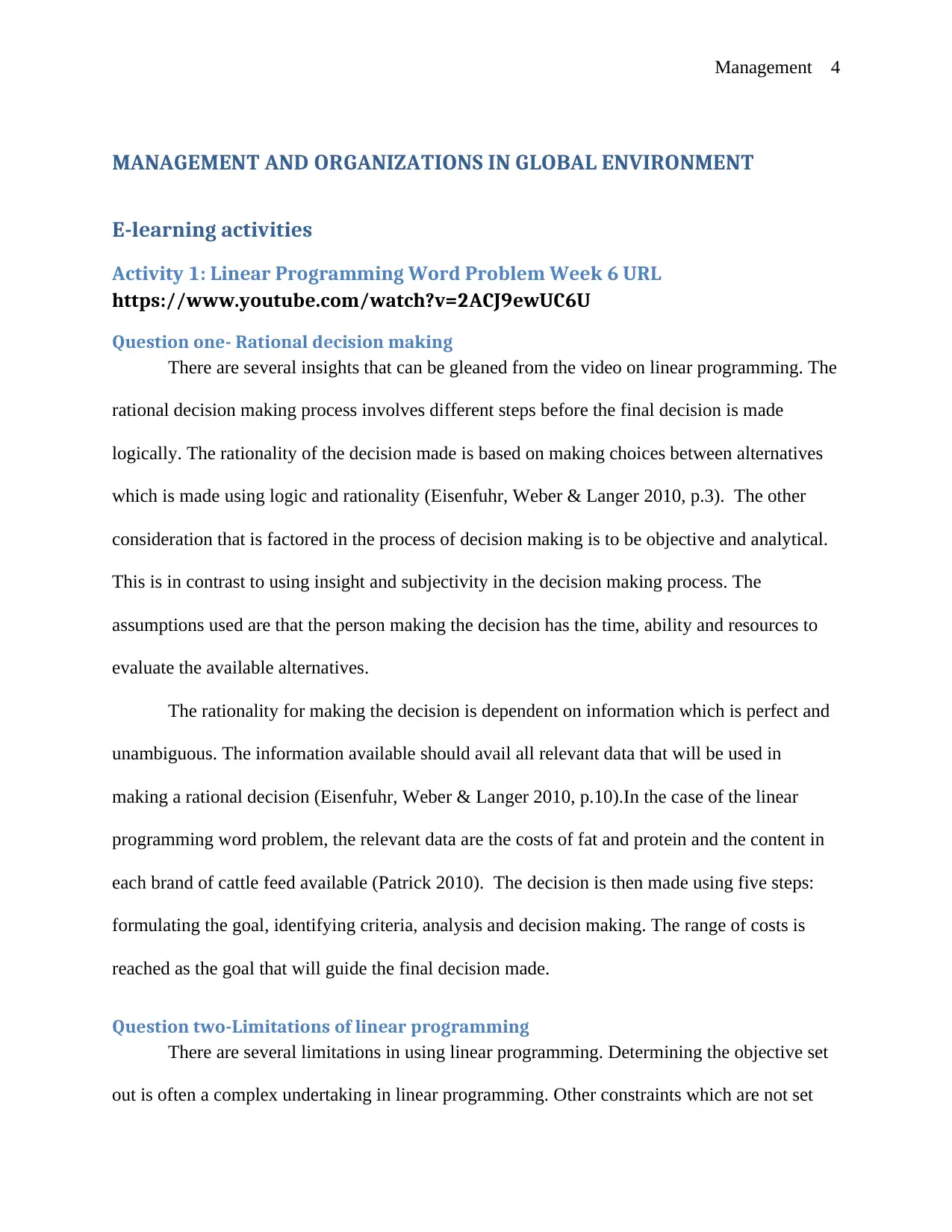
Management 4
MANAGEMENT AND ORGANIZATIONS IN GLOBAL ENVIRONMENT
E-learning activities
Activity 1: Linear Programming Word Problem Week 6 URL
https://www.youtube.com/watch?v=2ACJ9ewUC6U
Question one- Rational decision making
There are several insights that can be gleaned from the video on linear programming. The
rational decision making process involves different steps before the final decision is made
logically. The rationality of the decision made is based on making choices between alternatives
which is made using logic and rationality (Eisenfuhr, Weber & Langer 2010, p.3). The other
consideration that is factored in the process of decision making is to be objective and analytical.
This is in contrast to using insight and subjectivity in the decision making process. The
assumptions used are that the person making the decision has the time, ability and resources to
evaluate the available alternatives.
The rationality for making the decision is dependent on information which is perfect and
unambiguous. The information available should avail all relevant data that will be used in
making a rational decision (Eisenfuhr, Weber & Langer 2010, p.10).In the case of the linear
programming word problem, the relevant data are the costs of fat and protein and the content in
each brand of cattle feed available (Patrick 2010). The decision is then made using five steps:
formulating the goal, identifying criteria, analysis and decision making. The range of costs is
reached as the goal that will guide the final decision made.
Question two-Limitations of linear programming
There are several limitations in using linear programming. Determining the objective set
out is often a complex undertaking in linear programming. Other constraints which are not set
MANAGEMENT AND ORGANIZATIONS IN GLOBAL ENVIRONMENT
E-learning activities
Activity 1: Linear Programming Word Problem Week 6 URL
https://www.youtube.com/watch?v=2ACJ9ewUC6U
Question one- Rational decision making
There are several insights that can be gleaned from the video on linear programming. The
rational decision making process involves different steps before the final decision is made
logically. The rationality of the decision made is based on making choices between alternatives
which is made using logic and rationality (Eisenfuhr, Weber & Langer 2010, p.3). The other
consideration that is factored in the process of decision making is to be objective and analytical.
This is in contrast to using insight and subjectivity in the decision making process. The
assumptions used are that the person making the decision has the time, ability and resources to
evaluate the available alternatives.
The rationality for making the decision is dependent on information which is perfect and
unambiguous. The information available should avail all relevant data that will be used in
making a rational decision (Eisenfuhr, Weber & Langer 2010, p.10).In the case of the linear
programming word problem, the relevant data are the costs of fat and protein and the content in
each brand of cattle feed available (Patrick 2010). The decision is then made using five steps:
formulating the goal, identifying criteria, analysis and decision making. The range of costs is
reached as the goal that will guide the final decision made.
Question two-Limitations of linear programming
There are several limitations in using linear programming. Determining the objective set
out is often a complex undertaking in linear programming. Other constraints which are not set
Paraphrase This Document
Need a fresh take? Get an instant paraphrase of this document with our AI Paraphraser
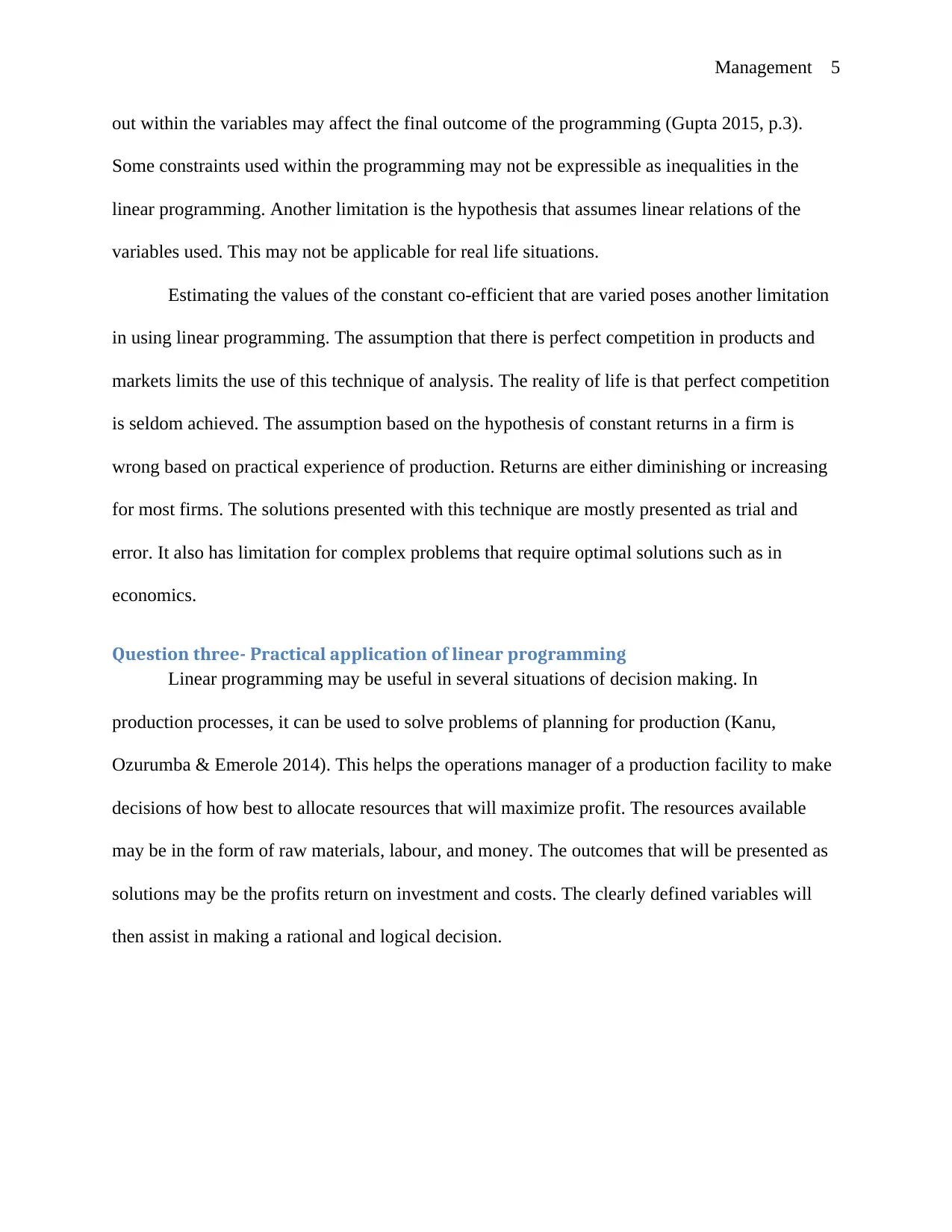
Management 5
out within the variables may affect the final outcome of the programming (Gupta 2015, p.3).
Some constraints used within the programming may not be expressible as inequalities in the
linear programming. Another limitation is the hypothesis that assumes linear relations of the
variables used. This may not be applicable for real life situations.
Estimating the values of the constant co-efficient that are varied poses another limitation
in using linear programming. The assumption that there is perfect competition in products and
markets limits the use of this technique of analysis. The reality of life is that perfect competition
is seldom achieved. The assumption based on the hypothesis of constant returns in a firm is
wrong based on practical experience of production. Returns are either diminishing or increasing
for most firms. The solutions presented with this technique are mostly presented as trial and
error. It also has limitation for complex problems that require optimal solutions such as in
economics.
Question three- Practical application of linear programming
Linear programming may be useful in several situations of decision making. In
production processes, it can be used to solve problems of planning for production (Kanu,
Ozurumba & Emerole 2014). This helps the operations manager of a production facility to make
decisions of how best to allocate resources that will maximize profit. The resources available
may be in the form of raw materials, labour, and money. The outcomes that will be presented as
solutions may be the profits return on investment and costs. The clearly defined variables will
then assist in making a rational and logical decision.
out within the variables may affect the final outcome of the programming (Gupta 2015, p.3).
Some constraints used within the programming may not be expressible as inequalities in the
linear programming. Another limitation is the hypothesis that assumes linear relations of the
variables used. This may not be applicable for real life situations.
Estimating the values of the constant co-efficient that are varied poses another limitation
in using linear programming. The assumption that there is perfect competition in products and
markets limits the use of this technique of analysis. The reality of life is that perfect competition
is seldom achieved. The assumption based on the hypothesis of constant returns in a firm is
wrong based on practical experience of production. Returns are either diminishing or increasing
for most firms. The solutions presented with this technique are mostly presented as trial and
error. It also has limitation for complex problems that require optimal solutions such as in
economics.
Question three- Practical application of linear programming
Linear programming may be useful in several situations of decision making. In
production processes, it can be used to solve problems of planning for production (Kanu,
Ozurumba & Emerole 2014). This helps the operations manager of a production facility to make
decisions of how best to allocate resources that will maximize profit. The resources available
may be in the form of raw materials, labour, and money. The outcomes that will be presented as
solutions may be the profits return on investment and costs. The clearly defined variables will
then assist in making a rational and logical decision.
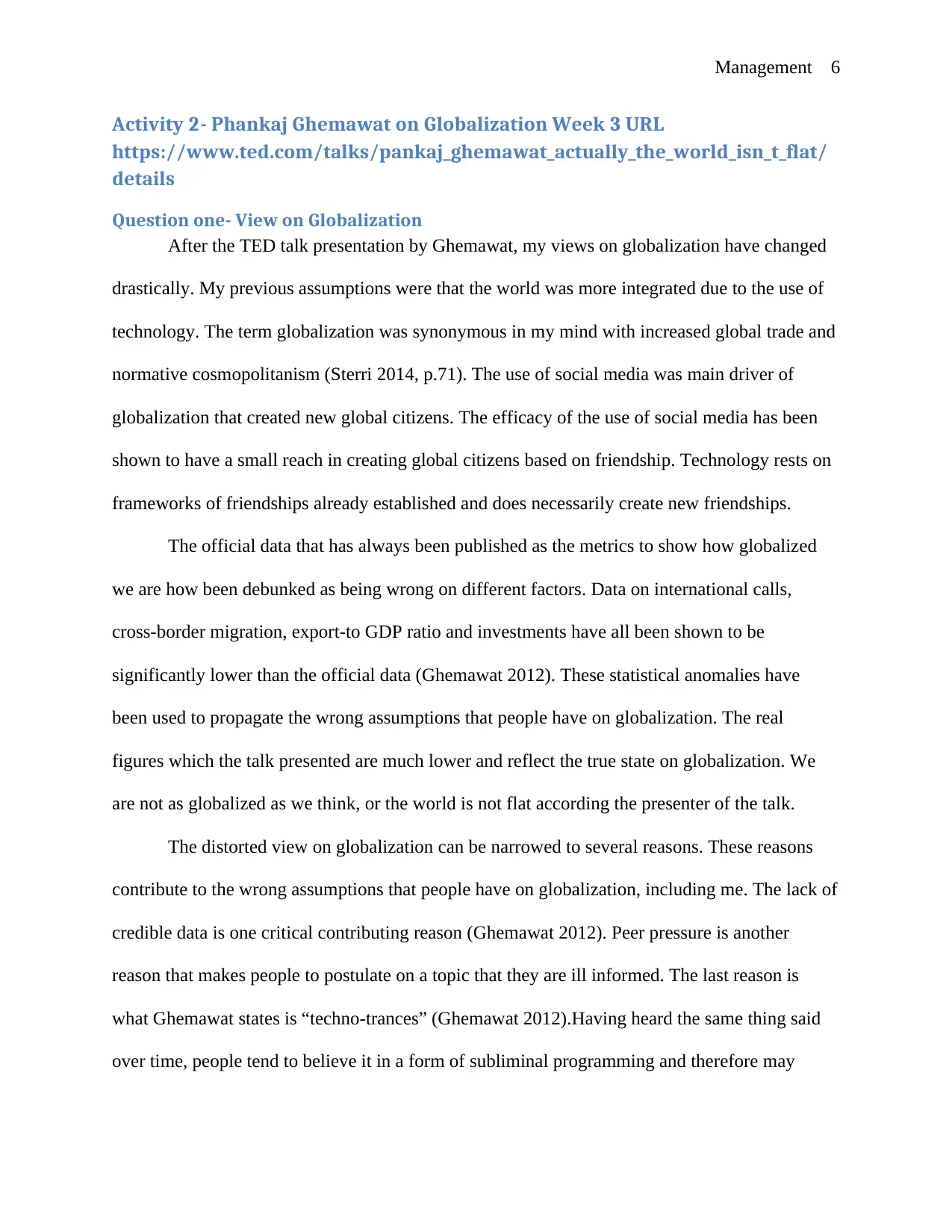
Management 6
Activity 2- Phankaj Ghemawat on Globalization Week 3 URL
https://www.ted.com/talks/pankaj_ghemawat_actually_the_world_isn_t_flat/
details
Question one- View on Globalization
After the TED talk presentation by Ghemawat, my views on globalization have changed
drastically. My previous assumptions were that the world was more integrated due to the use of
technology. The term globalization was synonymous in my mind with increased global trade and
normative cosmopolitanism (Sterri 2014, p.71). The use of social media was main driver of
globalization that created new global citizens. The efficacy of the use of social media has been
shown to have a small reach in creating global citizens based on friendship. Technology rests on
frameworks of friendships already established and does necessarily create new friendships.
The official data that has always been published as the metrics to show how globalized
we are how been debunked as being wrong on different factors. Data on international calls,
cross-border migration, export-to GDP ratio and investments have all been shown to be
significantly lower than the official data (Ghemawat 2012). These statistical anomalies have
been used to propagate the wrong assumptions that people have on globalization. The real
figures which the talk presented are much lower and reflect the true state on globalization. We
are not as globalized as we think, or the world is not flat according the presenter of the talk.
The distorted view on globalization can be narrowed to several reasons. These reasons
contribute to the wrong assumptions that people have on globalization, including me. The lack of
credible data is one critical contributing reason (Ghemawat 2012). Peer pressure is another
reason that makes people to postulate on a topic that they are ill informed. The last reason is
what Ghemawat states is “techno-trances” (Ghemawat 2012).Having heard the same thing said
over time, people tend to believe it in a form of subliminal programming and therefore may
Activity 2- Phankaj Ghemawat on Globalization Week 3 URL
https://www.ted.com/talks/pankaj_ghemawat_actually_the_world_isn_t_flat/
details
Question one- View on Globalization
After the TED talk presentation by Ghemawat, my views on globalization have changed
drastically. My previous assumptions were that the world was more integrated due to the use of
technology. The term globalization was synonymous in my mind with increased global trade and
normative cosmopolitanism (Sterri 2014, p.71). The use of social media was main driver of
globalization that created new global citizens. The efficacy of the use of social media has been
shown to have a small reach in creating global citizens based on friendship. Technology rests on
frameworks of friendships already established and does necessarily create new friendships.
The official data that has always been published as the metrics to show how globalized
we are how been debunked as being wrong on different factors. Data on international calls,
cross-border migration, export-to GDP ratio and investments have all been shown to be
significantly lower than the official data (Ghemawat 2012). These statistical anomalies have
been used to propagate the wrong assumptions that people have on globalization. The real
figures which the talk presented are much lower and reflect the true state on globalization. We
are not as globalized as we think, or the world is not flat according the presenter of the talk.
The distorted view on globalization can be narrowed to several reasons. These reasons
contribute to the wrong assumptions that people have on globalization, including me. The lack of
credible data is one critical contributing reason (Ghemawat 2012). Peer pressure is another
reason that makes people to postulate on a topic that they are ill informed. The last reason is
what Ghemawat states is “techno-trances” (Ghemawat 2012).Having heard the same thing said
over time, people tend to believe it in a form of subliminal programming and therefore may
⊘ This is a preview!⊘
Do you want full access?
Subscribe today to unlock all pages.

Trusted by 1+ million students worldwide
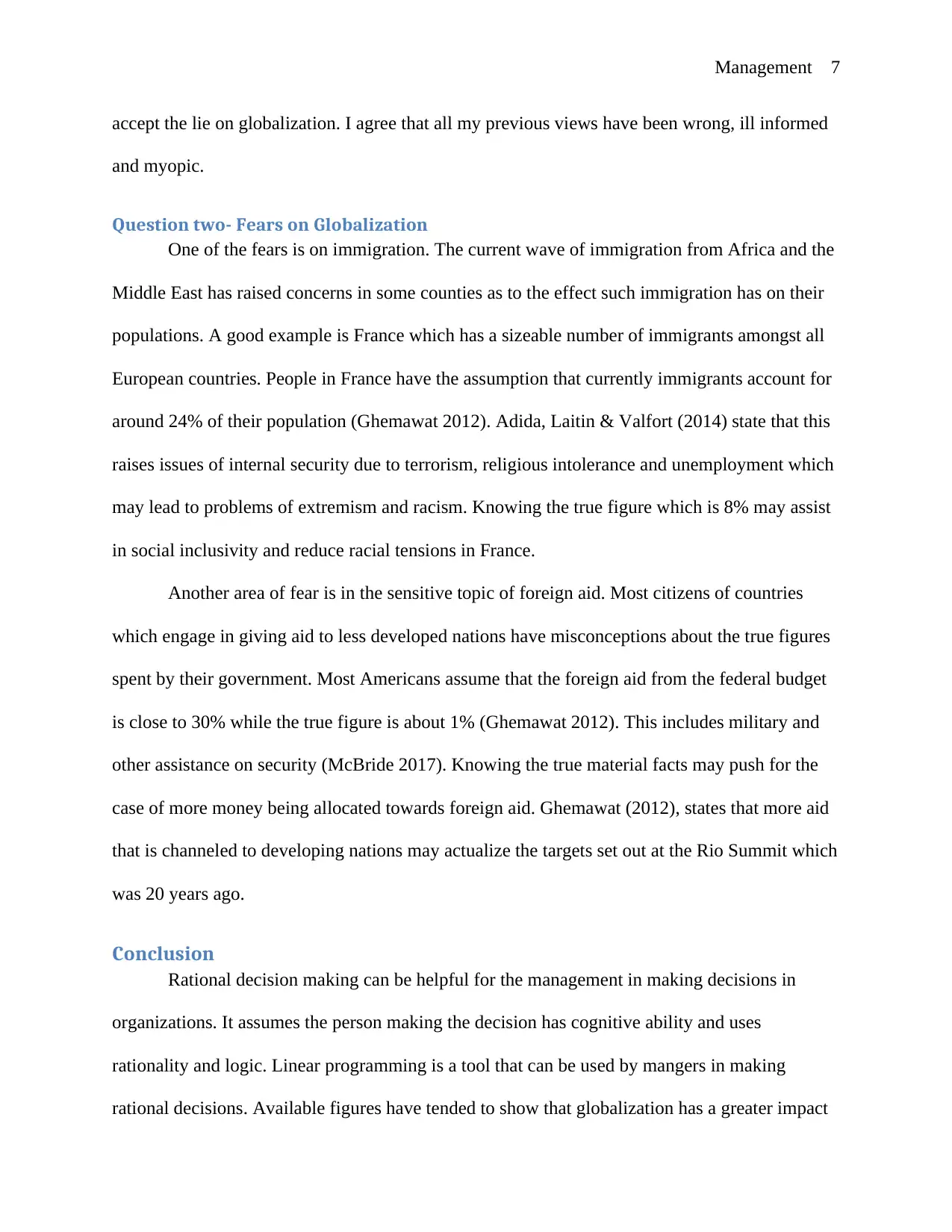
Management 7
accept the lie on globalization. I agree that all my previous views have been wrong, ill informed
and myopic.
Question two- Fears on Globalization
One of the fears is on immigration. The current wave of immigration from Africa and the
Middle East has raised concerns in some counties as to the effect such immigration has on their
populations. A good example is France which has a sizeable number of immigrants amongst all
European countries. People in France have the assumption that currently immigrants account for
around 24% of their population (Ghemawat 2012). Adida, Laitin & Valfort (2014) state that this
raises issues of internal security due to terrorism, religious intolerance and unemployment which
may lead to problems of extremism and racism. Knowing the true figure which is 8% may assist
in social inclusivity and reduce racial tensions in France.
Another area of fear is in the sensitive topic of foreign aid. Most citizens of countries
which engage in giving aid to less developed nations have misconceptions about the true figures
spent by their government. Most Americans assume that the foreign aid from the federal budget
is close to 30% while the true figure is about 1% (Ghemawat 2012). This includes military and
other assistance on security (McBride 2017). Knowing the true material facts may push for the
case of more money being allocated towards foreign aid. Ghemawat (2012), states that more aid
that is channeled to developing nations may actualize the targets set out at the Rio Summit which
was 20 years ago.
Conclusion
Rational decision making can be helpful for the management in making decisions in
organizations. It assumes the person making the decision has cognitive ability and uses
rationality and logic. Linear programming is a tool that can be used by mangers in making
rational decisions. Available figures have tended to show that globalization has a greater impact
accept the lie on globalization. I agree that all my previous views have been wrong, ill informed
and myopic.
Question two- Fears on Globalization
One of the fears is on immigration. The current wave of immigration from Africa and the
Middle East has raised concerns in some counties as to the effect such immigration has on their
populations. A good example is France which has a sizeable number of immigrants amongst all
European countries. People in France have the assumption that currently immigrants account for
around 24% of their population (Ghemawat 2012). Adida, Laitin & Valfort (2014) state that this
raises issues of internal security due to terrorism, religious intolerance and unemployment which
may lead to problems of extremism and racism. Knowing the true figure which is 8% may assist
in social inclusivity and reduce racial tensions in France.
Another area of fear is in the sensitive topic of foreign aid. Most citizens of countries
which engage in giving aid to less developed nations have misconceptions about the true figures
spent by their government. Most Americans assume that the foreign aid from the federal budget
is close to 30% while the true figure is about 1% (Ghemawat 2012). This includes military and
other assistance on security (McBride 2017). Knowing the true material facts may push for the
case of more money being allocated towards foreign aid. Ghemawat (2012), states that more aid
that is channeled to developing nations may actualize the targets set out at the Rio Summit which
was 20 years ago.
Conclusion
Rational decision making can be helpful for the management in making decisions in
organizations. It assumes the person making the decision has cognitive ability and uses
rationality and logic. Linear programming is a tool that can be used by mangers in making
rational decisions. Available figures have tended to show that globalization has a greater impact
Paraphrase This Document
Need a fresh take? Get an instant paraphrase of this document with our AI Paraphraser
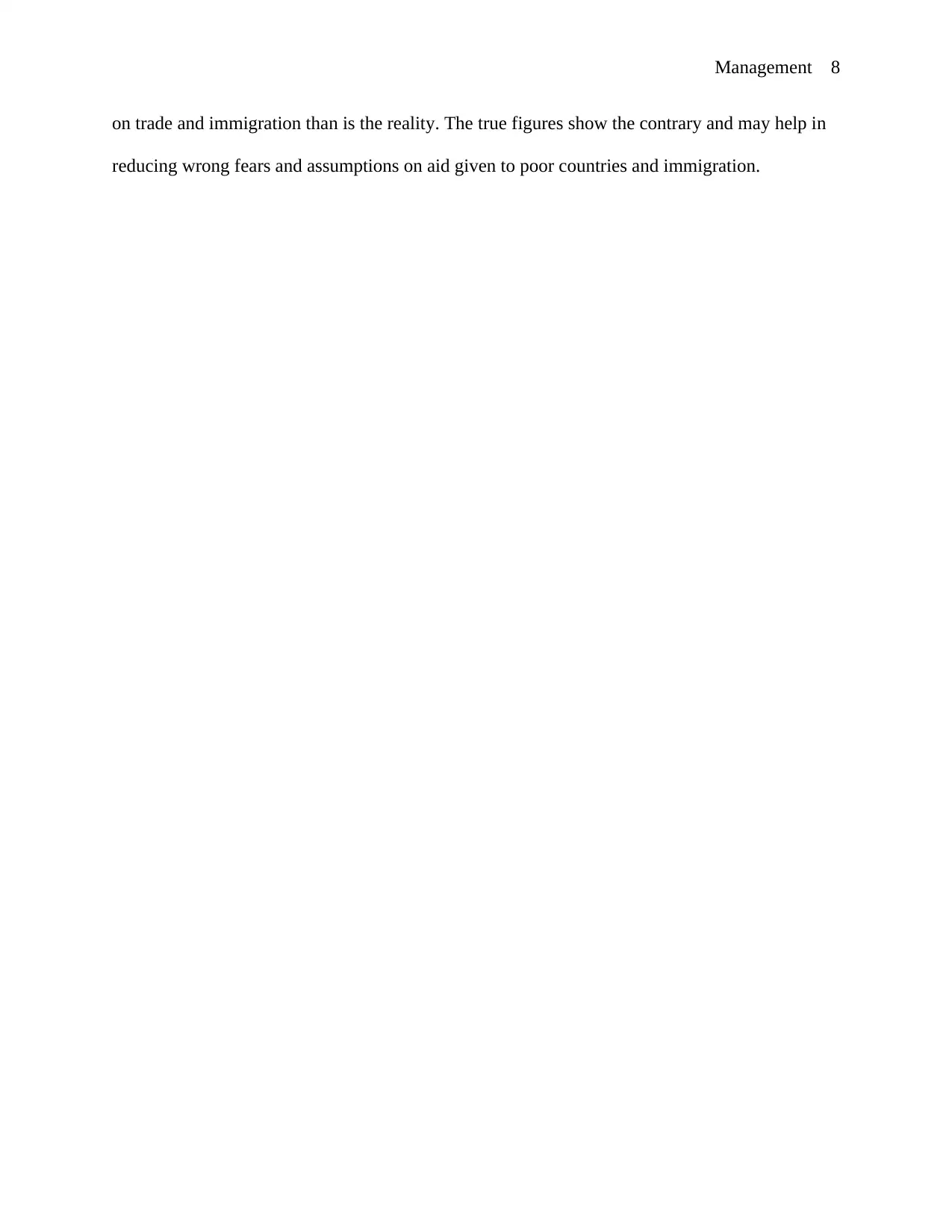
Management 8
on trade and immigration than is the reality. The true figures show the contrary and may help in
reducing wrong fears and assumptions on aid given to poor countries and immigration.
on trade and immigration than is the reality. The true figures show the contrary and may help in
reducing wrong fears and assumptions on aid given to poor countries and immigration.
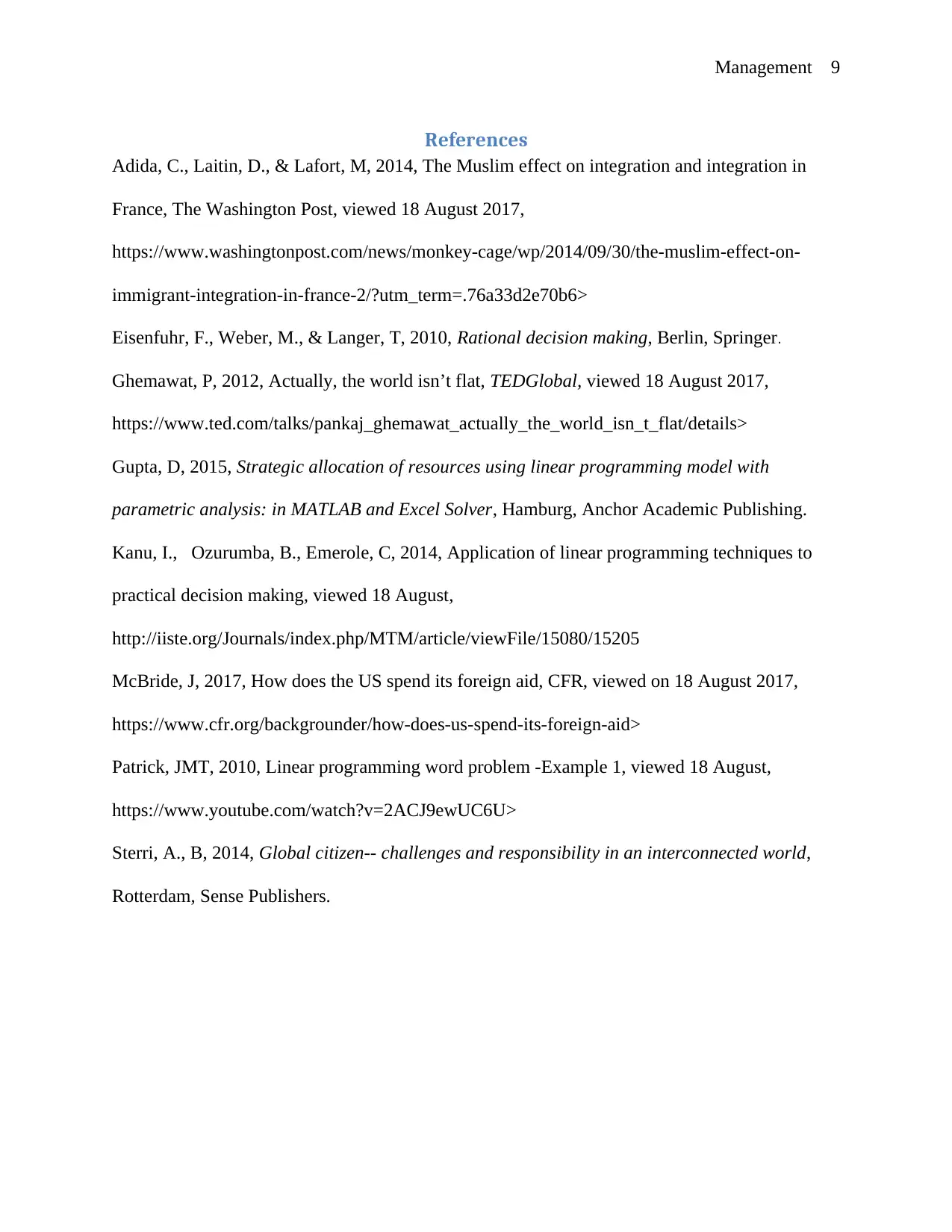
Management 9
References
Adida, C., Laitin, D., & Lafort, M, 2014, The Muslim effect on integration and integration in
France, The Washington Post, viewed 18 August 2017,
https://www.washingtonpost.com/news/monkey-cage/wp/2014/09/30/the-muslim-effect-on-
immigrant-integration-in-france-2/?utm_term=.76a33d2e70b6>
Eisenfuhr, F., Weber, M., & Langer, T, 2010, Rational decision making, Berlin, Springer.
Ghemawat, P, 2012, Actually, the world isn’t flat, TEDGlobal, viewed 18 August 2017,
https://www.ted.com/talks/pankaj_ghemawat_actually_the_world_isn_t_flat/details>
Gupta, D, 2015, Strategic allocation of resources using linear programming model with
parametric analysis: in MATLAB and Excel Solver, Hamburg, Anchor Academic Publishing.
Kanu, I., Ozurumba, B., Emerole, C, 2014, Application of linear programming techniques to
practical decision making, viewed 18 August,
http://iiste.org/Journals/index.php/MTM/article/viewFile/15080/15205
McBride, J, 2017, How does the US spend its foreign aid, CFR, viewed on 18 August 2017,
https://www.cfr.org/backgrounder/how-does-us-spend-its-foreign-aid>
Patrick, JMT, 2010, Linear programming word problem -Example 1, viewed 18 August,
https://www.youtube.com/watch?v=2ACJ9ewUC6U>
Sterri, A., B, 2014, Global citizen-- challenges and responsibility in an interconnected world,
Rotterdam, Sense Publishers.
References
Adida, C., Laitin, D., & Lafort, M, 2014, The Muslim effect on integration and integration in
France, The Washington Post, viewed 18 August 2017,
https://www.washingtonpost.com/news/monkey-cage/wp/2014/09/30/the-muslim-effect-on-
immigrant-integration-in-france-2/?utm_term=.76a33d2e70b6>
Eisenfuhr, F., Weber, M., & Langer, T, 2010, Rational decision making, Berlin, Springer.
Ghemawat, P, 2012, Actually, the world isn’t flat, TEDGlobal, viewed 18 August 2017,
https://www.ted.com/talks/pankaj_ghemawat_actually_the_world_isn_t_flat/details>
Gupta, D, 2015, Strategic allocation of resources using linear programming model with
parametric analysis: in MATLAB and Excel Solver, Hamburg, Anchor Academic Publishing.
Kanu, I., Ozurumba, B., Emerole, C, 2014, Application of linear programming techniques to
practical decision making, viewed 18 August,
http://iiste.org/Journals/index.php/MTM/article/viewFile/15080/15205
McBride, J, 2017, How does the US spend its foreign aid, CFR, viewed on 18 August 2017,
https://www.cfr.org/backgrounder/how-does-us-spend-its-foreign-aid>
Patrick, JMT, 2010, Linear programming word problem -Example 1, viewed 18 August,
https://www.youtube.com/watch?v=2ACJ9ewUC6U>
Sterri, A., B, 2014, Global citizen-- challenges and responsibility in an interconnected world,
Rotterdam, Sense Publishers.
⊘ This is a preview!⊘
Do you want full access?
Subscribe today to unlock all pages.

Trusted by 1+ million students worldwide
1 out of 9
Related Documents
Your All-in-One AI-Powered Toolkit for Academic Success.
+13062052269
info@desklib.com
Available 24*7 on WhatsApp / Email
![[object Object]](/_next/static/media/star-bottom.7253800d.svg)
Unlock your academic potential
Copyright © 2020–2025 A2Z Services. All Rights Reserved. Developed and managed by ZUCOL.





